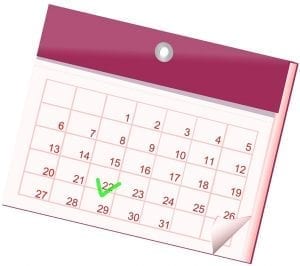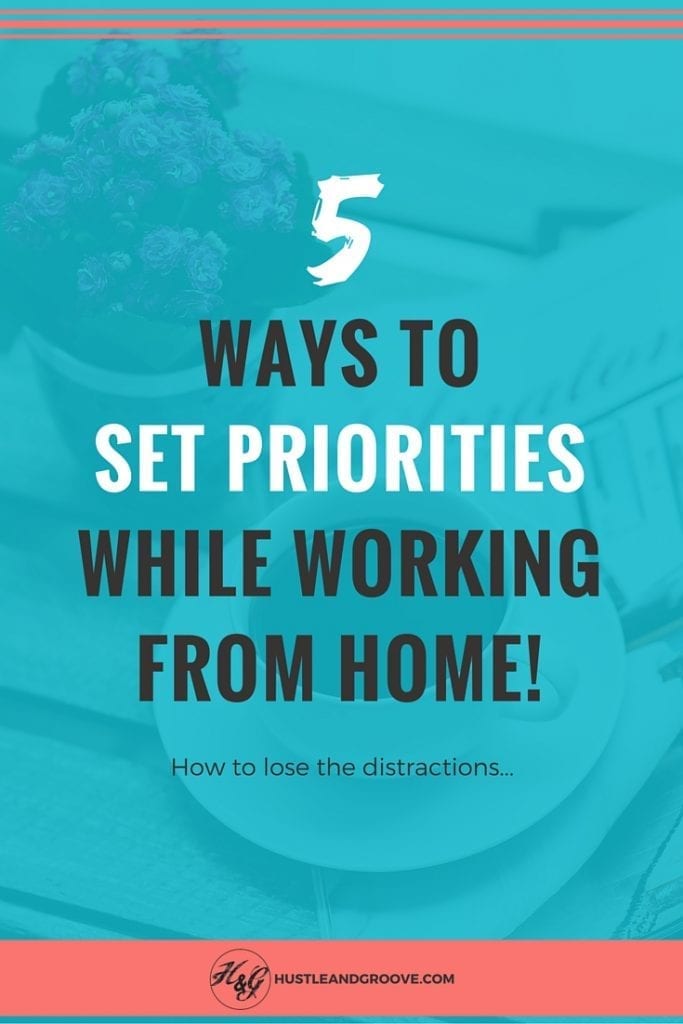Table of Contents
How amazing is it to work from home? Whether you're a full time groover like me or still balancing your day job with your side hustle, being able to work from home is pure bliss…
Or is it?
When I was working my day job, I dreamed of being able to work from home, waking up in the morning to sunshine, a hot coffee and something delicious for breakfast.
Then I'd read for half an hour, easing my way into the day and staying completely focused on the tasks I had set out to achieve that day.
Basically, I believed I'd be able to do so much more, working from home and be more productive…
Only it didn't pan out that way, at least not initially.
The key to being able to work from home successfully is largely based on your priorities… or rather, how are you setting your priorities?
Six months into my full-time freelance career — I was feeling more than overwhelmed — I couldn't understand why I, someone who is super organised, was struggling to stay on top of everything.
It wasn't until someone pointed out to me that I should take a look at the way I was prioritising my day… and figure out how to handle multiple priorities.
Once I did this, the grey skies cleared and the sun began to shine… and I want to share with you the strategies I used so you can implement these for yourself and enjoy working from home as much as I do!
5 Ways to Set Priorities When Working From Home
I don't know about you, but working from home can be distracting… particularly if you're like me and tend to multi-task… a huge no-no if you actually wanna get stuff done!
What's distracting about working from home, you might be thinking? Here's how my typical day goes (distractions included):
Wake up at 5am, walk out to the kitchen to boil the jug and OMG, the dishwasher wasn't put on last night… switch jug on while filling dishwasher and oh man, the sink is dirty… better clean that too.
Jug boils, make my coffee and then walk over to my office… and notice that the pile of washing from yesterday is still sitting over on the chair. Make a mental note that I need to get to that some time today.
Sit down to write my morning pages and can literally hear the washing screaming at me to be folded… then I notice that the floor hasn't been vacuumed…
You get the drift! And that's just the chores around the house, it doesn't include Facebook messages, text messages and interruptions from my hubby etc.
It is more than distracting at my home!
So a slight disclaimer here… these things still happen at home, but I now prioritise EVERYTHING, so that everything that needs to get done has a task home.
Making mental notes is not conducive to productivity, right?!
Ok, let's jump into those strategies!
#1: Track what you do during the day
 Write down EVERYTHING you do, whether it's writing a blog post, taking the kids to school, making dinner, catching up with a friend, jumping on a mastermind call, writing emails, creating sales pages etc, etc.
Write down EVERYTHING you do, whether it's writing a blog post, taking the kids to school, making dinner, catching up with a friend, jumping on a mastermind call, writing emails, creating sales pages etc, etc.
Take a notebook with you one day this week and note down what you're doing and when and how long it takes you. I know it might seem annoying, but trust me, once you do this it is VERY eye-opening…
If you want to really make sure you capture everything, do this for 7 days to get a full run-down on what you do during the day. If you do this, it will surprise you, it surprised me! When you actually see what you're doing with your 24 hours, you can start to see why you're so overwhelmed.
If you're still working your day job, write down the hours you're at your day job and then record everything else outside those hours, in detail.
This is really important. If you don't do this first, it makes the rest of this blog post a complete waste of time.
#2: Analyse your day-tracking results
Now that you've got a notebook full of details of what you do in a day (or a week), it's time to break those things down into buckets.
Your buckets are going to be slightly different to mine, but you'll understand more once you see them…
My buckets:
- Client work
- H&G work
- Home chores
- Personal
- Social media
- Family
Once you've identified your buckets, now you need to go and put everything that you wrote down in your day or week into a one of these buckets.
For example, if you pick up the kids from school every other day, then that belongs in your ‘family' bucket. If you're side hustle involves writing blog posts, put that in client work or create a bucket called “side hustle” to capture those tasks.
These buckets will help you figure out what your priorities are on a given day and also make it very clear where you're spending your time.
#3: Review your goals against your buckets
Once you've got your buckets full of tasks, now it's time to think about how your buckets align with your goals.
At this point, you'll want to take a step back and figure out what's important to you:
What are your non-negotiables that you must do every day or every week?
Highlight or star these so that you know that on any given day, these are the things that you must do that day, regardless of everything else going on.
For me, that's my exercise and reading for 30 minutes a day. They are my non-negotiables and as such, I work around these two things and fit everything else in.
For you, these could be things like spending time with your kids, jumping on a mastermind call, applying for gigs on Upwork etc. Whatever your non-negotiables are, make it obvious to yourself now.
 Review Your Goals
Review Your Goals
Now we can pull out your goals and review these against your buckets.
In most instances, these should be similar in terms of having big goals for these different areas of your life… if you have a bucket that doesn't have a goal associated with it, then it requires some investigating further.
Still not sure what I'm talking about? Here's an example:
Let's use the family bucket example from above. On your goals list, do you have some family-related goals? If you don't, you probably should, right?
When you start looking at your buckets and the tasks within those buckets, you should be able to see which ones align with your goals and which ones are just busy tasks… things that distract you. For me, that's the washing or any house-related chore!
Now, these tasks probably still need to get done, obviously, but do YOU need to be doing them? Can you outsource them (or hire a cleaner!) to take care of some of these?
If you're bootstrapping or are on a budget, then consider batching all these ‘distracting' tasks into a specific time so that you get them done all at once (if possible). That way, you're only taking up space in a day, rather than spreading yourself (and your focus) thin throughout the week.
For example, when we couldn't afford a cleaner, I'd batch all those chores to a Friday night or Saturday morning, depending on what I had going on during the week. This way, I could just focus on getting that stuff then and not be distracted by it during the week…
Make sense?
#4: Set priorities daily
One thing I learned about working from home is that on any given day, things can change. I'm sure you've experienced the same.
Which is why it makes no sense to set your priorities and then never review them! In fact, I'd recommend that you set priorities daily instead, so that you have the flexibility to adjust as needed.
One of the best ways of doing this is to incorporate this into your evening routine, where you could review the tasks for the next day and then pick out your top three priorities, because you should never have more than three things you're focusing on in a day. This, of course, excludes your non-negotiables…
By setting priorities this way, you allow for other life things to happen. Our lives are not structured, they don't look the same every day, so why would you drive yourself nuts by trying to set your priorities to be the same, every, single, day?
Yes, there are going to be some things that have to be done daily… but those are your non-negotiables, right?
If you're struggling to figure out what your priorities are, consider putting in anything that is a daily must-do as a non-negotiable, so that you then free up your brain to assign priorities based on everything else that's left.
#5: Visualise your priorities
 Now, this might not work for everyone, but I'm guessing that there are a lot of you out there who are just like me — you need to see it in order for it to really make sense.
Now, this might not work for everyone, but I'm guessing that there are a lot of you out there who are just like me — you need to see it in order for it to really make sense.
For me, that means having a digital to-do list in Todoist, colour-coded to projects and batching as well as a big calendar on the wall for overarching plans and then a daily planner to capture my thoughts and plan out my day in a way that is more meaningful to me… with lots of colour and stickers!
I use my big calendar to plan out things like launches, guest blog posts, trips away etc. I can quickly glance at it and get a sense of where I'm at in the month and two months ahead (total of 3 months on the wall).
It also helps me keep track of the actual date, as I cross days off… it can be hard to keep track of days when you work from home, because you don't really have the same routine like you did when working and you're weekends can kind of extend… 🙂
When it comes to working from home, if you don't set priorities, it can become overwhelming and if you're trying to balance your side hustle with your day job, you could start to drop all the balls you're juggling.
Save yourself the stress and implement these strategies. If you don't, you might find yourself with a very unhappy side hustle business and a ton of angry clients… 🙁




6 replies to "How to Set Priorities When Working From Home"
Great practical advice here – especially the ‘non-negotiables’ such as exercise and reading.
I work to a weekly timetable, blocking out my time for different task, but I do include time each week for training / personal development. And I also end each working day by making a list of priorities for the next day so I can hit the ground running and not procrastinate!
Thanks Elizabeth ? love the list of priorities at the end of the day, great idea, thanks for sharing.
[…] swamped with tasks and don’t know where to begin. Break your workload into manageable chunks by writing daily task lists and arranging those responsibilities in order of […]
[…] most important part of setting up a schedule in Google Calendar is making sure that you color-code […]
Thank you so much for this blog post, Lise! I really do need to track what I’m doing during the day just to see if I could be doing something different to accomplish even more. Setting priorities can be a huge help to me so I can get more accomplished. I’m all about accomplishing as much as possible due to perfectionism.
You’re so welcome Lisa, I hope you were able to implement!